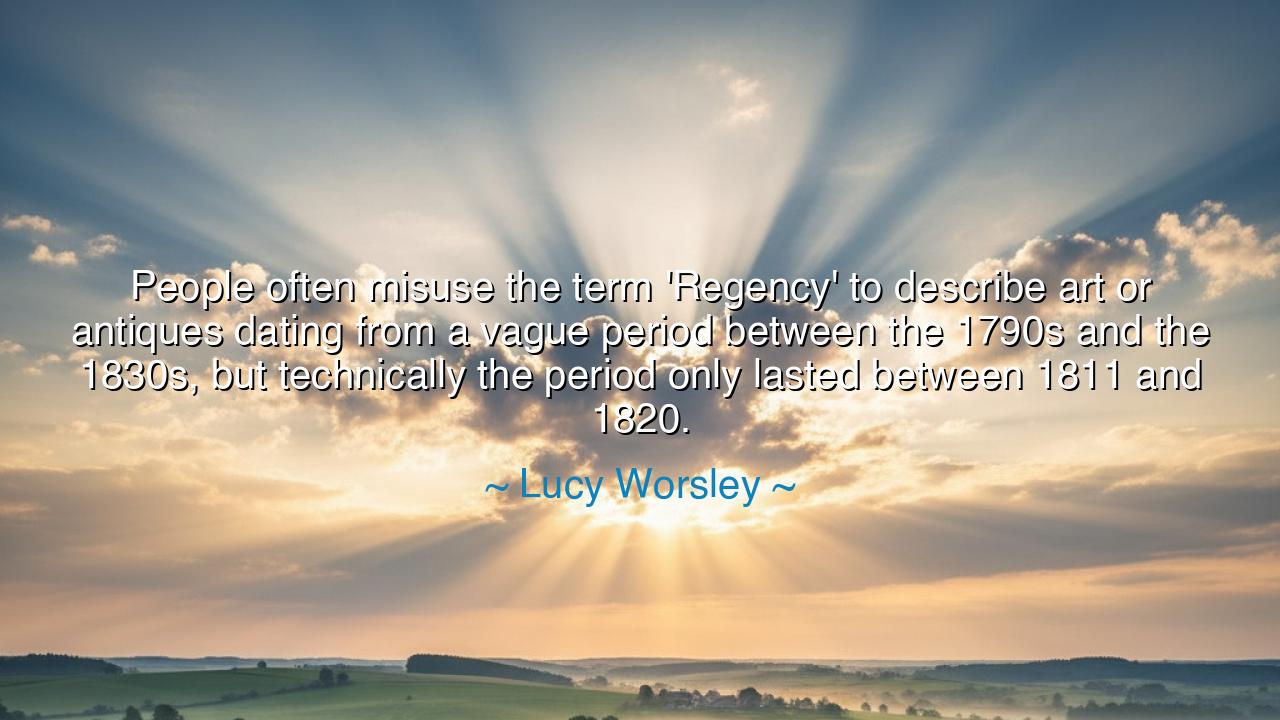
People often misuse the term 'Regency' to describe art or
People often misuse the term 'Regency' to describe art or antiques dating from a vague period between the 1790s and the 1830s, but technically the period only lasted between 1811 and 1820.






In the hushed galleries where mahogany remembers the touch of vanished hands, the historian Lucy Worsley speaks with a curator’s bell: “People often misuse the term ‘Regency’ to describe art or antiques dating from a vague period between the 1790s and the 1830s, but technically the period only lasted between 1811 and 1820.” Hear the precision within the poetry. She is not scolding, but rescuing a name. For names, like heirlooms, carry weight: they anchor memory to a shore. Call a thing by its right century, and you summon not mist, but a morning—one with dates, laws, and living persons whose breath once warmed the world.
The ancients prized exactness in sacred matters; so should we in history. The Regency was not a mood nor a color palette alone—it was the legal span when George, Prince of Wales, governed as Prince Regent during his father’s incapacity, from 1811 until 1820, when he became George IV. Those nine years are a clasp, fastening a specific bracelet of time. Beyond them stretches the broader cultural tide—late Georgian and early Hanoverian tastes—whose eddies swirl from the 1790s into the 1830s, yes; but the clasp itself has a click you can hear if you listen: Acts passed, courts convened, patronage granted, fashions fixed to a sovereign’s hand.
Why does this matter? Because language is a chisel. Call an 1810 sideboard “Regency,” and you shave away the last year of George III’s reign; label an 1825 chair “Regency,” and you smuggle the early George IV years under a banner that no longer flies. The market’s convenience favors vagueness; scholarship demands contours. To keep the contours is to respect the craftsmen who worked within them—the cabinetmaker whose bill bore the Regent’s crest, the architect who drew with Brighton’s glitter in mind, the dressmaker who cut silhouettes for assemblies under a specific court.
A tale from the auction room: a dealer once brought forth a “Regency” armchair with lion monopodia, burnished and proud, dated—by family letter—to 1805. The catalogue swelled with adjectives, but a quiet scholar asked for the invoice and the timber’s dendrochronology. The truth emerged: late Georgian, Sheraton’s influence, crafted on the cusp yet outside the ring of 1811–1820. The hammer still fell, the chair still shone, but its story sharpened. Price adjusted; history restored. Such victories are not merely pedantic—they are acts of fidelity to the dead who deserve the dignity of their own day.
Consider a counter-echo. The dazzling Royal Pavilion at Brighton flowered through the mid-1810s and finished after 1820; Jane Austen’s novels (1811–1817) breathed within the Regent’s decade; Beau Brummell’s creed of restraint polished the male silhouette just then. These belong rightly to Regency, while the Gothic and Egyptian revivals that surged deeper into the 1820s–1830s belong to a crown already changed. See how clarity lets us trace cause and consequence: a prince’s patronage, a tailor’s line, a novelist’s irony—all bound to a precise hinge of time.
From this, a lesson fit for the apprentices of memory: do not let soft fog steal the coastline. When we learn to distinguish Regency (the 1811–1820 regency itself) from the looser “Regency-era style” that dealers and decorators stretch from the 1790s to the 1830s, we gain more than correctness; we gain story. Dates are not cages; they are frames. Within them, art converses with policy, taste with power, and furniture with the bodies it once supported.
Practical rites for keepers of the past: (1) Pair every object with a date range you can defend; mark sources—maker’s labels, invoices, ledger entries. (2) Learn the signatures of the years 1811–1820—the lines of Nash, the restraint of Brummell, the silhouette of Austen’s world—so your eye knows the Regent’s fingerprint. (3) Use adjacent names when needed: say “late Georgian (pre-Regency)” for the 1790s–1810, and “George IV/early Victorian” beyond 1820, rather than smearing all beneath Regency. (4) When buying or writing, choose precision over panache; your prose will shine more brightly for it. (5) Teach the young that accuracy is a form of love—the kind that returns lost things to their rightful rooms.
So let Worsley’s reminder stand as a boundary stone on the road of time. Honor the narrow decade of the true Regency; admire, but do not confuse, the wider fashions that bookend it. For in calling each era by its proper name, we do what our foremothers did with their household ledgers: we keep honest accounts. And honest accounts, in history as in trade, are the beginning of wisdom—and the foundation upon which beauty may be rightly praised.






AAdministratorAdministrator
Welcome, honored guests. Please leave a comment, we will respond soon